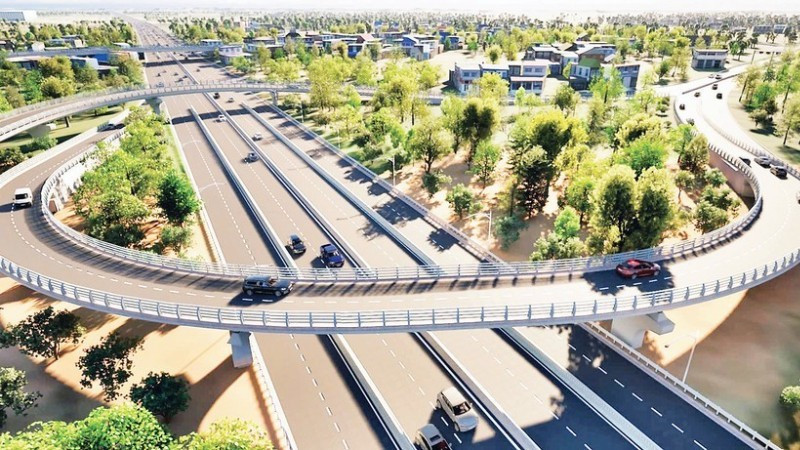Development driving force for border areas in Southeast region
Investment in the border areas of the Southeast region has great significance in the socio-economic development strategy, associated with ensuring national defence and security of the region.

The strategy, focusing on infrastructure investment, expanding trade, developing the border-gate economy, logistics and services, will create an important driving force for breakthrough growth in this potential-rich border area.
After the merger, Dong Nai and Tay Ninh Provinces have about 627km of border, accounting for more than 50% of the total border length with neighbouring Cambodia. Along the entire border, there are 27 communes, mostly remote, ethnic minority-inhabited and mountainous communes.
To promote the advantage of large land funds and development space, Dong Nai and Tay Ninh Provinces pay special attention to mobilising investment resources for socio-economic development, hunger eradication, and poverty reduction.
Striving to build a bright future
For many years, Dong Nai and Tay Ninh Provinces have issued many policies to develop social infrastructure and improve the lives of local people. In the eight border communes of Dong Nai Province, there are 84 socio-economic development projects invested by communes in 2025. Of these, Bu Gia Map Commune is the investor for 30 projects with a total capital of 36.412 billion VND.
“Bu Gia Map Commune is a remote and ethnic minority-inhabited area of Dong Nai Province, with 75% of the population being ethnic minorities. In recent years, the commune has been allocated many resources, including investment for socio-economic development and poverty reduction, which have shown positive results,” Tran Lam, Chairman of the People’s Committee of Bu Gia Map Commune, said.
Loc Thanh is one of the eight border communes of Dong Nai Province. It has three schools, all of which are primary and secondary inter-level schools. Among them, Loc Thinh Primary and Secondary School faces many difficulties in facilities, especially at its satellite campuses.
Implementing Conclusion Notice No. 81-TB/TW on July 18, 2025, by the Politburo on the policy of investing in building schools for border communes, Dong Nai Province recently started the construction of 17 classrooms, three student-support-rooms, four auxiliary rooms, two administrative rooms, as well as a multi-purpose hall and auxiliary facilities for Loc Thinh Primary and Secondary School.
In addition, at a satellite campus, one classroom, one teachers’ room, a parking lot for students and other items are being built with a total investment of more than 35 billion VND.
Exploiting potential and advantages
The Southeast region has five international border gates and four border-gate economic zones. This creates favourable conditions for provinces to make breakthroughs in the trade economy, contributing to socio-economic development and improving the lives of people in border areas.
Truong Thanh Liem, Head of the Economic Zone Management Board of Tay Ninh Province, said that after reorganisation and merger, Tay Ninh Province has about 369km of borderline with neighbouring Cambodia, with four international border gates, four national border gates and 13 auxiliary border gates connecting with Cambodia’s Svay Rieng, Pray Veng and Tboung Khmum Provinces. To effectively exploit the trade economy, Tay Ninh has developed three border-gate economic zones covering 68,561ha. This is a major transit hub for goods between Viet Nam and Cambodia, and also a gateway connecting to the Greater Mekong Subregion.
In Dong Nai, there is Hoa Lu international border gate linked with the nearly 28,000ha Hoa Lu border-gate economic zone. This area is not only a hub for trading agricultural products, construction materials and machinery and equipment between Viet Nam and Cambodia but also a driving force for industrial and service development.
Nguyen Tan Duc, Chairman of the Dong Nai Provincial People’s Committee, said that the economic zones and border gates are the face of the province and the nation. Therefore, the province prioritises resources to develop connected transport infrastructure and economic zone infrastructure. At present, the important transport routes connecting the provincial centre to the border areas have been completely invested with four–six lanes.
The Government is implementing many expressway projects leading directly to border-gate economic zones, thereby contributing to completing the transport, logistics, trade and service infrastructure system, and attracting many investment projects in processing, import-export, border trade development associated with tourism, creating more resources for socio-economic development.
Notably, Ho Chi Minh City–Thu Dau Mot–Chon Thanh and the Ho Chi Minh City–Moc Bai international border gate expressways are two routes directly linking the southern economic hub of Ho Chi Minh City with international border gates and border-gate economic zones covering about 70,000ha.
The Ho Chi Minh City–Moc Bai expressway will connect with the Trans-Asian Highway – linking Myanmar through Thailand, Laos, Viet Nam, Cambodia and Guangxi (China). A completed transport infrastructure will help shorten travel time, reduce transportation costs, increase competitiveness, thereby creating favourable conditions for enterprises to invest in building factories, warehouses, logistics centres and trade services in border areas.
At the same time, it will help people in border areas travel and trade, expand production and business more conveniently, increase job opportunities, thereby improving incomes, contributing to poverty reduction and building new-style rural areas.








